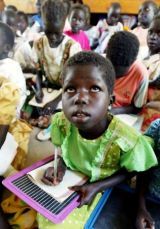1.3 million Children expected in South Sudan schools this year
April 1, 2008 (JUBA) – The number of southern Sudan children that have access to education increased to 1.3 million, thanks to the UNICEF-supported ‘Go to School’ initiative.

|
|
A Sudanese girl listens to her teacher as she attends a class along with over 150 other girls at Rumbek primary school in Southern Sudan April 19, 2004.. |
Launched in April 2006 by the Government of Southern Sudan’s Ministry of Education, Science and Technology, the initiative aims to bring enrolment levels to over 2 million.
Southern Sudan government has celebrated today Education Day and the second anniversary of the UNICEF-supported ‘Go to School’ initiative, which has currently brought 1.3 million pupils to school, compared to just 340,000 in 2005.
During the launch in 2006 H.E The FVP and President of GoSS Lt. Gen. Salva kiir decreed April 1 as Education Day in Southern Sudan.
In 2007, more than 500,000 children were encouraged back into the classrooms as a result of this initiative.
GoSS Minister of Education Job Dhoruai said, “I am thrilled by the progress we have made so far – the challenge for us now is to travel the next mile to ensure every Southern Sudanese child has access to quality education”.
Millions of school bags, books, pencils and other essential learning materials including those for teachers have been distributed by truck, boat and even on foot communities often in remote areas, with limited infrastructure.
However the UNICEF Country Representative in Sudan, Mr Ted Chaiban underlined that “the success of education depends not only on the number of children in the classrooms. We must also note that those charged with delivering education are fully supported.”
He further considered the launching of the Teacher Headcount as good step because it will give clear information in regards to the exact number of those currently teaching, their qualifications and their gender.
Of the 1.3 million children now in school, 34 per cent are girls, “a significant milestone in overturning taboos that had restricted girls from attending classes.” A UNICEF statement said.
During the war less than 1 per cent of girls completed their primary education, while an assessment of learning spaces conducted in 2006 showed that of the 2,922 schools in Southern Sudan, only 16 per cent had permanent buildings.
The UNICEF further has supported the Government of Southern Sudan to develop over 200 new permanent classrooms, as well as rehabilitating nearly 300 existing classrooms. Over 400 emergency classroom tents have also been provided to ensure shelter for outdoor schools while permanent construction gets underway.
(ST)
